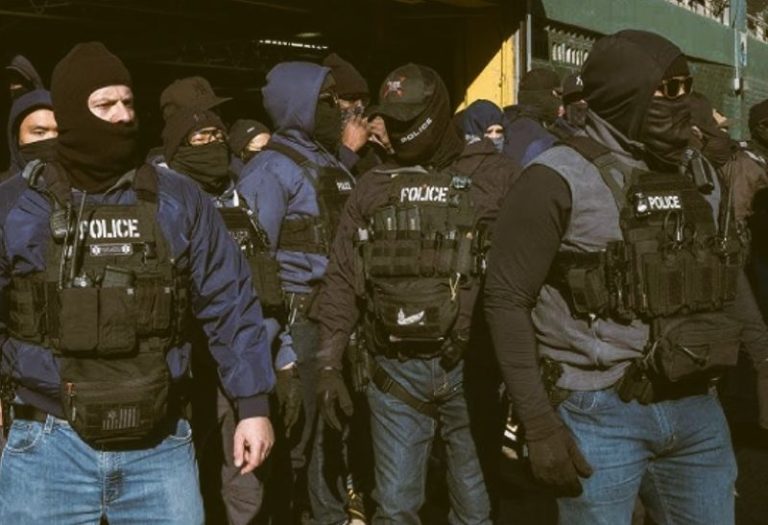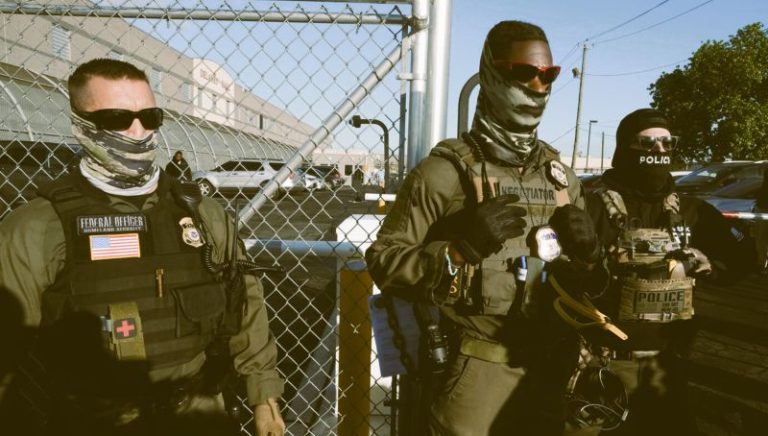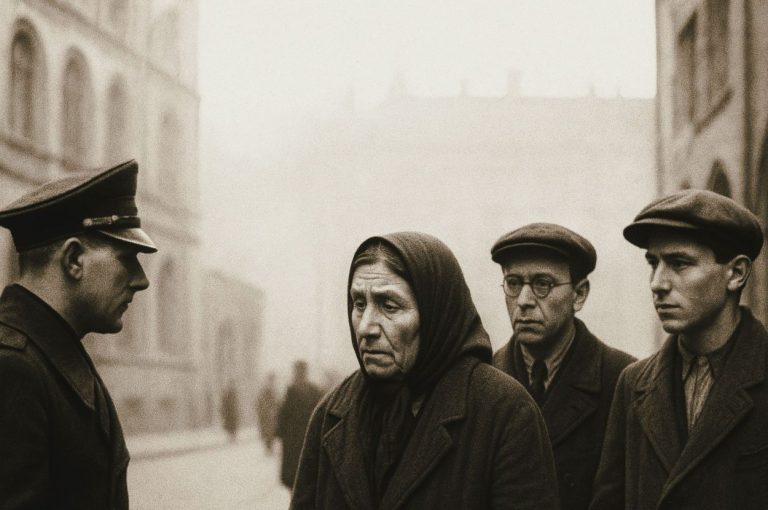
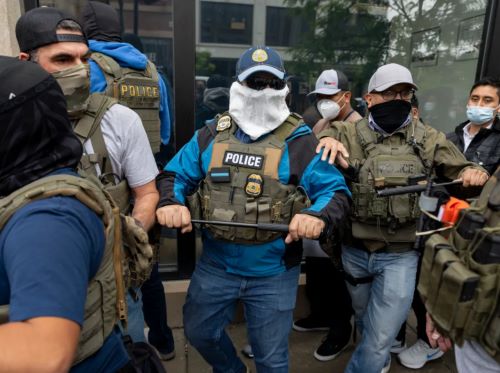
When federal power wears a mask, it is not only immigrants who should be concerned. It is every American who believes that liberty means more than the absence of chains.

By Matthew A. McIntosh
Public Historian
Brewminate
A Mission Lost in the Fog
When Immigration and Customs Enforcement was created in 2003, its stated purpose was clear: enforce federal immigration laws, protect national security, and investigate cross-border crime. In the aftermath of 9/11, this mission carried a sense of urgency and legitimacy. But in the decades since, the agency has morphed into something else entirely, a sprawling, secretive force whose methods increasingly resemble those of a rogue outfit rather than a lawful government agency.
Across the country, ICE agents conduct early morning raids in unmarked vehicles. They operate in plainclothes with little to no identification. They bypass warrants, stake out homes, and detain individuals without due process. Their presence is rarely announced in advance, and their operations are often shielded from local oversight. In some cities, they ignore court orders. In others, they threaten those who film them.
What began as a government agency now feels, in many immigrant communities, like a masked gang with federal funding.
Disguised Agents and Covert Raids
One of the most alarming trends in recent years has been the normalization of plainclothes ICE operations. Agents have been documented showing up at homes posing as local police, delivery workers, or even census takers. Once the door opens, a flurry of questions and handcuffs follows. Often, no warrant is produced. Sometimes, the agents rely on deception or intimidation to gain access.
The Fourth Amendment was designed to protect against exactly this kind of unchecked intrusion. Yet ICE continues to exploit ambiguities in the law, especially in immigration cases, which fall under civil rather than criminal jurisdiction. This technicality allows ICE to operate with far fewer constitutional restrictions than, for example, the FBI or local police.
Even more disturbing is the use of “collateral arrests.” During a raid targeting a specific individual, agents often detain anyone else present who lacks proper documentation, even if they have committed no crime. It is guilt by proximity, a practice that undermines both individual rights and community trust.
These tactics are not isolated. Reports from New York, Los Angeles, Houston, and smaller towns alike paint a consistent picture: ICE is operating not as a law enforcement body with accountability, but as a force unto itself.
Fear as a Tool
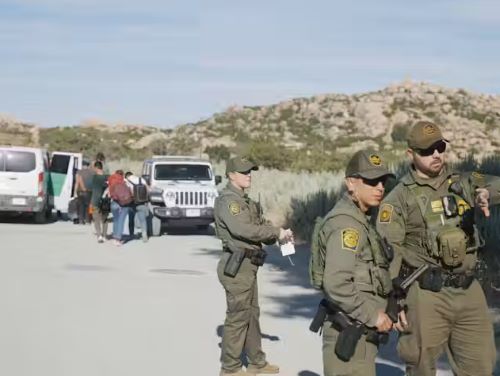
Fear is not a side effect of ICE strategy. It is a tool. By making their presence unpredictable and their actions opaque, agents rely on psychological warfare to do their work for them. People stop going to work. They avoid schools and hospitals. They hesitate to call the police when in danger.
That chilling effect is not limited to undocumented immigrants. Green card holders, DACA recipients, and even naturalized citizens have reported harassment or wrongful detention by ICE officers. In one high-profile case from 2019, a U.S. citizen was held in detention for over three weeks because ICE refused to believe his passport was valid.
In neighborhoods where ICE operates heavily, trust in government erodes. So does civic engagement. When a federal agency behaves like a clandestine force, it teaches people that rights are conditional and justice is selective.
The long-term impact of that lesson is corrosive.
Legal Gray Zones and Courtroom Evasions
ICE’s behavior increasingly tests, and often ignores, constitutional boundaries. Agents have entered courtrooms to detain individuals appearing for unrelated legal matters. Some were victims testifying in domestic violence cases. Others were showing up to traffic hearings.
This form of courthouse enforcement has drawn sharp rebukes from judges and legal scholars. It undermines the very foundation of a fair legal system. When people are afraid to appear in court, the integrity of that system collapses. Prosecutors lose witnesses. Defendants miss hearings. Victims suffer in silence.
ICE defends these tactics as necessary for national security. But many of its targets are not threats. They are parents, workers, students, and neighbors. By framing immigration enforcement as a war, the agency justifies combat tactics in peacetime settings.
And when challenged, ICE often refuses to engage. Lawsuits have been met with claims of federal immunity. Requests for public records are delayed or denied. Transparency becomes another casualty.
The Privatization Pipeline
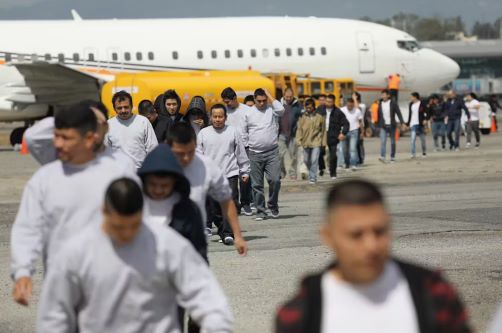
Beneath all of this runs a profitable engine. ICE contracts heavily with private detention companies, many of which lobby for stricter enforcement policies to keep their facilities full. GEO Group and CoreCivic, two of the largest, have reaped billions from federal contracts.
These private prisons are notorious for poor conditions, minimal oversight, and human rights violations. Medical neglect, unsanitary living quarters, and verbal abuse are common complaints. Suicides and preventable deaths have occurred in multiple facilities.
By turning immigration detention into a commercial enterprise, the government has created a system where arrest and incarceration are not just policy choices but economic incentives. The more people ICE detains, the more revenue these companies earn.
This structure raises a troubling question: how can justice be served when it is tied to profit?
Local Resistance and the Shifting Legal Landscape
Despite the reach of ICE, resistance is growing. Some cities have adopted sanctuary policies, refusing to honor ICE detainers unless a judicial warrant is presented. Others have severed contracts with private detention facilities or passed ordinances prohibiting local cooperation with federal raids.
Legal victories have also begun to accumulate. Courts have ruled that ICE cannot detain individuals indefinitely without a hearing. Some judges have questioned the agency’s use of outdated data to justify raids. A few have gone further, suggesting that aspects of ICE operations may be fundamentally unconstitutional.
Still, the structure remains intact. Federal funding flows. Contracts are renewed. And the raids continue.
A Crisis of Democratic Accountability
At its core, the transformation of ICE is not just a policy issue. It is a democratic crisis. An agency that operates with secrecy, resists oversight, and routinely violates civil rights poses a direct threat to constitutional governance.
Immigration enforcement is a legitimate function of government. But enforcement without accountability becomes repression. It abandons the principles of due process and equal protection. It replaces legal process with intimidation and swaps the rule of law for the rule of fear.
What ICE has become is not inevitable. It is the result of choices (political, legal, and cultural) that prioritized punishment over protection, and secrecy over standards.
The time to ask who ICE is really serving, and at what cost, is long overdue.
When federal power wears a mask, it is not only immigrants who should be concerned. It is every American who believes that liberty means more than the absence of chains.
Originally published by Brewminate, 07.23.2025, under the terms of a Creative Commons Attribution-NonCommercial-NoDerivatives 4.0 International license.
